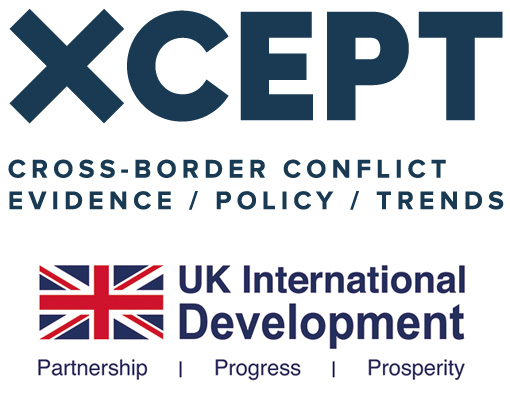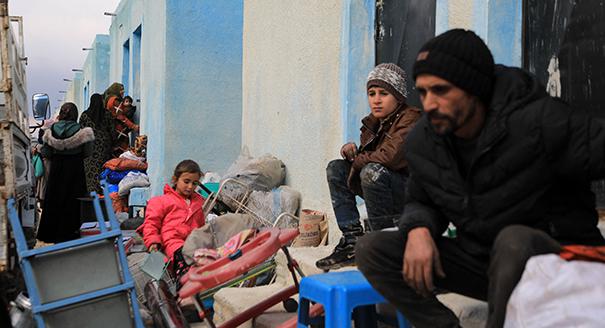Armenak Tokmajyan is a nonresident scholar at the Malcolm H. Kerr Carnegie Middle East Center in Beirut. His research focuses on borders and conflict, Syrian refugees, and state-society relations in Syria. Recently, he authored a Carnegie paper with Kheder Khaddour, titled “Border Nation: The Reshaping of the Syrian-Turkish Borderlands.” Diwan interviewed Tokmajyan in late April to discuss his paper.
Michael Young: You’ve just written a paper, with Kheder Khaddour, titled “Border Nation: The Reshaping of the Syrian-Turkish Borderlands.” What is the main idea that you try to get across for readers?
Armenak Tokmajyan: In the past decade, the Syrian conflict has divided northern Syria into three semiautonomous regions—the northeast, where an affiliate of the Kurdistan Worker Party (PKK), which Ankara considers an enemy, is in control; the center, where three cantons are subject to strong Turkish influence; and Idlib, in the northwest, ruled by a local Islamist group, Hay’at Tahrir al-Sham, which is, or was, affiliated with Al-Qaeda. There are different socioeconomic patterns in these areas. While governing structures differ in Idlib and the cantons under Turkey’s sway, both regions are socially and economically connected to Turkish border governorates such as Sanliurfa, Gaziantep, Kilis, and Reyhanli. In contrast, northeastern Syria, which is under Kurdish control, is separated from Turkey by a hard border.
The paper acknowledges these differences, but it argues that in spite of them, Syria’s north outside of th Assad regime’s control is strongly tied to Turkey’s border policies, and its fate is interlinked with the security of the Turkish-Syrian border. In that sense, the whole of northern Syria is part of a single political-security ecosystem. In other words, social and governing orders may differ from Qamishli to Idlib, but a military action in Idlib will surely have implications in the northeast, and vice versa, because the entire border region is part of a single security formula. This, in turn, means that a sustainable solution (which doesn’t seem imminent) could prevail only if Syria and Turkey, along with their allies, were to come to a new understanding of how the entire borderland should look like.
MY: How has Syrian society in the border area with Turkey changed in the past decade, and do you think it possible that the situation there can going back to what existed before the uprising in 2011?
AT: There is no going back to pre-2011 situation. That’s for sure. The transformations that we’ve witnessed in the past decade are immense. Take economic and demographic factors, for example. Aleppo, which was the economic powerhouse of the entire north, is destroyed and marginalized, and rebuilding the city will take years. The wartime economic order in the northwest is based on trade with or via Turkey, and in this context, we’ve seen the formation of economic hubs near the border with Turkey such as Sarmada and Azaz.
Demographically, the area has faced massive shifts. Violence uprooted millions of people within Syria, and pushed many others out of the country. About half of the population in the nonregime northwest includes internally displaced persons, for example. Idlib hosts a sizable population from Aleppo, Deir al-Zor, and southern Syria. There have also been numerous cases of demographic engineering along the border by political actors. Also, it is important to note that Turkey hosts around 3.7 million Syrian refugees, just under 60 percent of whom live near the Syrian border. These changes will have a lasting effect regardless how the conflict progresses.
MY: How successful, or unsuccessful, has Turkish policy been in the border areas it controls? Have the Turks been able to achieve their aims against the Kurdish-dominated Syrian Democratic Forces, which it sees as an extension of the Kurdistan Workers Party? And have they created a viable economic system there?
AT: Turkey’s border policies have been a mixed success. Ankara has been able to physically secure its borders by building a wall and closely managing border crossings. Its military interventions and economic support have created a sort of a buffer zone that protects Turkey’s own border. Together, these policies have prevented major, uncontrolled human mobility toward Turkey. At the same time, the importance of border security for Turkey, its military intervention, and its absolute rejection of taking in new refugees, have all given the Syrian regime and Russia a valuable tool with which to pressure Turkey when needed. Moreover, the rate of refugee return from Turkey to northern Syria has been less than what Turkey had hoped for.
Concerning the northeast, since 2012 Turkey has found itself neighboring an affiliate of the PKK, its arch enemy. In recent years, Turkey has been aggressively trying to prevent the formation of a PKK-dominated statelet in Syria. And it has taken several measures to that end, including military incursions in Afrin and the northeast. Yet Ankara has thus far failed to kill the Kurdish project in Syria, particularly due to U.S. military support to the Kurds, whom Washington considers to be important partners in the fight against the Islamic State group. All in all, northern Syria represents a major demographic and security dilemma for Turkey. The way out of this situation is unclear.
MY: If you had to guess what the Syrian-Turkish border region would look like in, let’s say five years, what would you predict?
AT: I think the current state of the affairs will change. The relative calm in the north should not be mistaken for the end of the war, particularly because the current status quo is not acceptable either for Turkey or for the regime in Damascus, both of which are in an offensive position. They possess the means to change the status quo through violence, negotiations, and bartering, all of which will come at the expense of the three political projects that remain in the north—that of Hay’at Tahrir al-Sham, of the Syrian opposition, and of the autonomous Kurdish administration. In other words, the space that exists between the regime and Turkey in the north will shrink at the expense of the local actors there.







